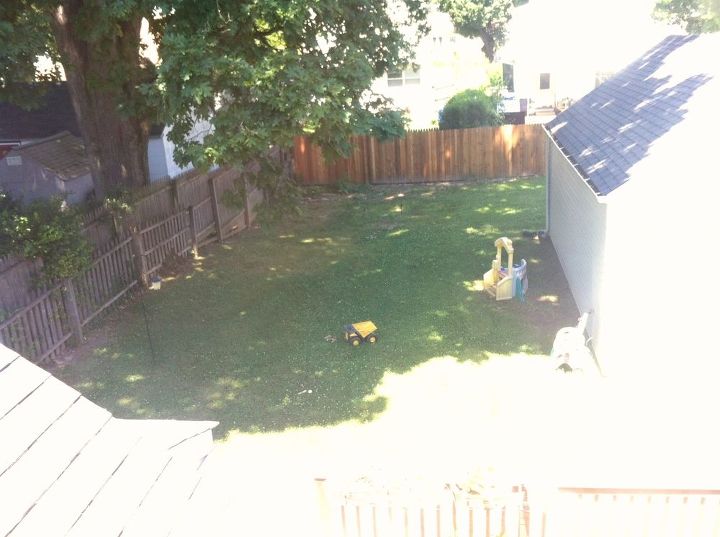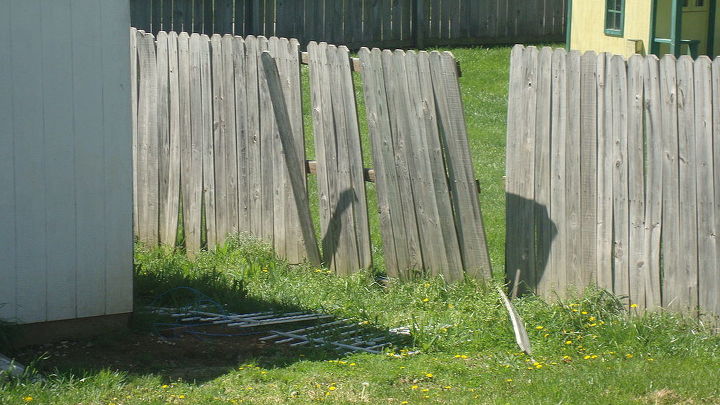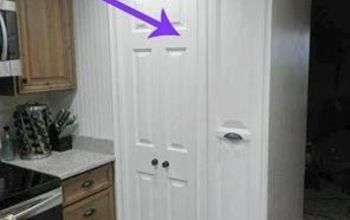How can I reclaim part of yard where lots of water collects?

I've gotten suggestions from a few local landscapers. One suggested running a drain pipe underground to the street with an immersed pump in a pit in the watery area. I'm very skeptical of this because it is a long uphill run to the street. I'm not convinced a pump would work given that.
Another suggested regrading to elevate the lower part stopping a foot or two short of the fence line. In the remaining gully against the fence, the suggestion was to install flowell dry wells to pull the water down. I'm skeptical of this solution as well because the soil is more clay-like and I don't want to just push water back into neighbors yards.
Anyone have any experience with or suggestions for a situation like this?
-
A tough situation....you're downhill from everyone else. I'll be curious to see what others suggest.
 Walter Reeves
on Jun 24, 2012
Helpful Reply
Walter Reeves
on Jun 24, 2012
Helpful Reply -
-
Have you considered putting in a drain? If you go to Lowe's or Home Depot, you'll find they have the drain boxes and pipe to install this. You can bury the solid black pipe "x" number of feet away from the low spot, then change to the perforated pipe "x" number of feet from the low spot, allowing the water to discharge and perk somewhere else.
 Becky H
on Jun 24, 2012
Helpful Reply
Becky H
on Jun 24, 2012
Helpful Reply -
-
Have spoken to the other neighbors? Although a pump will work, you will be spending all the money to fix their issue as well and it will cost you a lot of cash to keep the pump running when it rains. A large drainage pit can be dug and filled with several tons of crushed stone then covered back over again with soil. IN effect creating a place for the water to sit. The soil that remains can then be spread around raising the area so water will run off of the yard towards the street. But you will need to get the neighbors on board with this as any change in the soil height will most likely cause more flooding in their yards, Something all of you do not want to happen. I would suggest that you speak with the local township engineer. Because of mosquito populations and the fact anything you do will effect your neighbors. Perhaps the township engineer can assist you with some sort of an idea that will appease everyone concerned. Unless everyone is on board with the fix, you will need the townships blessing to protect you against any legal issue that one may cause if you begin to flood their yard because of anything you do. Remember there are easements on how close you can dig, or change things along your property line. The last thing I would suggest is to construct a block wall and garden around the corner of the property if you can come right up to the fence line. This garden can be a few feet high and a few feet wide. Fill with soil to create a planting bed for flowers and such. Then add more top soil to raise your yard up high enough so the water runs out towards either a underground pitched drain to the street, or just naturally runs due to grading.
 Woodbridge Environmental Tiptophouse.com
on Jun 24, 2012
Helpful Reply
Woodbridge Environmental Tiptophouse.com
on Jun 24, 2012
Helpful Reply -
-
Is your yard large enough that you could just turn that part into a bog garden, filled with pitcher plants and other plants that would thrive in those conditions? For some ideas, see: http://web.extension.illinois.edu/ccdms/yg/070714.html
 Douglas Hunt
on Jun 25, 2012
Helpful Reply
Douglas Hunt
on Jun 25, 2012
Helpful Reply -
-
Thank you all for the tips. @Woodbridge Environmetal: The neighbors have not been receptive in the past to other shared issues (ie the giant tree in the photo). I will definitely get in touch with the township engineers office to see what guidance they can provide. I know this is a delicate issue that should not be done without township involvement. @Douglas: A few people have mentioned water gardens but I wasn't quite sure what that meant. Thank you for this link. It seems to detail some of the options. I will have to dig into it.
 Dave K
on Jun 25, 2012
Helpful Reply
Dave K
on Jun 25, 2012
Helpful Reply -
-
Good luck, Dave. Let us know what you come up with. I'm sure other folks who face a similar situation would be interested.
 Douglas Hunt
on Jun 26, 2012
Helpful Reply
Douglas Hunt
on Jun 26, 2012
Helpful Reply -
-
At least your getting rain....with 10 active wildfires out here in Colorado we would love to have this problem. you might be able to use some "berms" to redirect the water to multiple locations this my speed the dry out phase as the overall quantity of water will be dispersed.
 KMS Woodworks
on Jun 26, 2012
Helpful Reply
KMS Woodworks
on Jun 26, 2012
Helpful Reply -
-
I agree - if you can't beat it, join it - as in not fighting the water, and putting in a bog garden, river rock, etc. A lot of counties will give you the rock needed for free, you provide the labor to install. Check with your local government, yours may even provide the labor!
 Jan C
on Jun 28, 2012
Helpful Reply
Jan C
on Jun 28, 2012
Helpful Reply -
-
You could split the difference. Regrade the yard sloping gently away from the house, so you get the flat yard you want, then landscape in some large rocks that define the border of the bog garden. Have that 'tumble down' the grade, the rocks getting smaller, eventually into gravel and sand, with the boggy plants tucked in and around all the rocks. It would give the appearance of having a little riverbed along the side and corner of the property. You'd get the same principle of the 'gully' suggested by the landscaper, without it looking like a boring little ditch!
 Joan Good
on Jul 21, 2012
Helpful Reply
Joan Good
on Jul 21, 2012
Helpful Reply -
-
Hi - I know it is the end of the summer & you posted in June -- But I would like to add my 2 cents.... The downspout on your garage should emptying toward the back - not the side - There are a variety of attachment and extesions to direct the run. I dug a out a basin at the end point and filled the bottom and sides with stone. I notice you have no plants growing in your back yard. You may have build a slight mound to filling the hollow where the pond forms surround it with flowering perenials and a small ornimental tree and the water that destroyed your grass will water your garden.
 Carol S
on Aug 07, 2012
Helpful Reply
Carol S
on Aug 07, 2012
Helpful Reply -
-
You should make it into a rain garden.
 Ksay
on Jul 01, 2013
Helpful Reply
Ksay
on Jul 01, 2013
Helpful Reply -
-
Save the rain water in rain water barrels. You might want to check the youtube for a diy projects on "How to install Rainwater barrels. You can re-use the rainwater to water your yard or vegetable, fruit, and flower garden during spring and summer seasons or use the rainwater you save for washing your car or dogs, etc... Good luck!
 Fat192415
on Jul 01, 2013
Helpful Reply
Fat192415
on Jul 01, 2013
Helpful Reply -
-
Go with the flow. Make a pond.
 Mickey Baron
on Apr 11, 2016
Helpful Reply
Mickey Baron
on Apr 11, 2016
Helpful Reply -
-
Put in a drain pipe and add more dirt in the yard
 Pat Bushue
on Apr 11, 2016
Helpful Reply
Pat Bushue
on Apr 11, 2016
Helpful Reply -
-
I don't know how long you have had this ground water pooling or how long you have lived there but it seems as though when the houses were built, the builders, town or city should have installed a storm sewer drain back there. Is it also possible that any of your neighbors or neighbors before you lived there have made changes to the elevation of their land and or somehow made changes to their land to cause your ground water pooling problem? I know by reading it sounds as though you are very thoughtful of your neighbors but here nor there, you may want to look around over the fence etc. to see what the elevations or changes in land look like and if there may even be a storm sewer drain situated on any of you neighbors property kiity corner back or side where as the storm sewer drain has been modified or changed somehow or is blocked. You can also talk to your neighbors to find out if they are also concerned with ground water pooling problems in their yard. I would also be concerned if this water is not going anywhere and you find that your sump pump runs for long period of time or your basement walls or basement is really damp or shows signs of wet walls or mold you maybe in for trouble with foundation problems? Good luck to you and just FYI it sounds odd all that standing water and I would do some investigation first before spending a lot of money or even like you said you don't want to cause ground water to move to your neighbors from any changes you make since if they start complaining, you will be responsible to re-do or undo what you have done if that is the case.
 Kathy Ann
on May 30, 2016
Helpful Reply
Kathy Ann
on May 30, 2016
Helpful Reply -
-
We had the same thing happening when we had lots of rain. We made a water garden
 Pat Bushue
on May 31, 2016
Helpful Reply
Pat Bushue
on May 31, 2016
Helpful Reply -
-
Did you ever get this resolved?
 Kate
on Sep 06, 2016
Helpful Reply
Kate
on Sep 06, 2016
Helpful Reply -
-
Get a post-hole digger, make several 4-foot holes near the fence, fill with gravel. Simple as that. They will collect the excess water.
 Connie wedding
on Sep 27, 2016
Helpful Reply
Connie wedding
on Sep 27, 2016
Helpful Reply -
-
I would call the city or county you live in. They will come out and evaluate the problem, fix if it is due to the neighborhood development and give you other options. The neighbors fence is holding the water that backs up. You can put in a french at the lowest area of the lawn but the pipe needs to exit somewhere down hill not uphill. The county or city will help you. Standing water is a big problem for mosquito infestation. Having your city or county engineers look at your area will make your fenced in neighbor buy into the fix. I have been through your nightmare. My city engineers were great.
 Stephanie corley
on Nov 12, 2016
Helpful Reply
Stephanie corley
on Nov 12, 2016
Helpful Reply -
Related Discussions
GNATS - How to get rid of them?
Somehow my house and garden got tiny gnats that killed my fuchsia plant and fly everywhere. I have tried ALL the Web recommendations - soap and oil dishes, sand in th... See more
Marigolds growing! Should I pinch the buds?
My marigold plants are growing. I heard that pinching the buds until Autumn will allow them to grow without killing the plant. Is this true?
Growing garlic
Growing our first garlic, should we wait until the leaves are drying out before we pick it? Husband picked first one today along with our first potatoes.
How to keep mice out of your garden?
Hi everyone, I have mice in my garden destroying my vegetables and I have also noticed them in the barn and shed. Please can someone tell me how to prevent them from ... See more
What's the best flower/plant to grow in Texas?
I know that opinions vary, but what's your opinion?!I have great luck w Rosemary plants. Green all year long.
Best way to kill bush/tree after being cut down?
Just moved into a new home. There was a huge thorny bush dragon devouring the mailbox. I slayed the dragon but it is trying to rise up again. How can I make sure it's... See more
Nightmare neighbors
We have the worst neighbors ever! They complain about everything! They hate dogs so they complain every time our dogs bark one time (not exaggerating) they have fabri... See more





